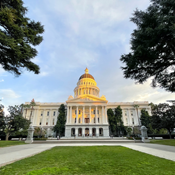
Definitions and California Lumber Products Assessment
Lumber Products and Engineered Wood Products
The Board of Forestry and Fire Protection (Board of Forestry) is responsible for determining the products that are subject to the lumber products assessment. See the Board of Forestry's Regulations, Lumber Products Assessment. The Board of Forestry is required to annually update their regulation.
In general, lumber products and engineered wood products subject to the assessment are building products usually used in construction in which wood is at least 10% of total content. For example all dimensions and grades of lumber, roofing, (shakes and wooden shingles), siding, lath, plywood, particle board, fiberboard, oriented strand board, I-joists, laminated veneer lumber, veneer-based sheeting material, and inorganic-bonded and wood thermoplastic composites, including plastic lumber and decking.
Based on guidance provided by Board of Forestry the lumber products assessment does not apply to products where labor has added 'significant value' to them, such as:
- furniture,
- doors,
- windows,
- decorative products such as wainscoting, paneling, molding or baseboards that have added profiling, patterns, chamfering or other craftsmanship.
However, the addition of any value to a lumber product does not automatically result in a product not subject to the assessment. Many lumber products undergo additional processing before being used, but are still subject to the assessment, for example lumber that is graded and planed. In addition, engineered wood products, which are subject to the assessment, have been, by definition, processed or manufactured from raw materials. Thus, it is important to consult the Board of Forestry's Regulation when trying to determine if a product is subject to the Lumber Products Assessment.
The Board of Forestry provides additional information on its website in a document entitled Guidance for classifying products under the Lumber Assessment. This document is intended to provide guidance in determining the products that are subject to the Lumber Products Assessment and does not have the same effect of the law. In instances where there is an inconsistency between the guidance and the law, the law is controlling.
The following listing is current as of July 31, 2014. We will add additional products as we receive further guidance from the Board of Forestry.
Products Subject to the Lumber Products Assessment
Solid Wood Products:
- all grades and dimensions of lumber
- structural panels
- cross-laminated timbers
- decking
- railings
- fencing (poles, solid board)
- poles
- roofing (shakes and wooden shingles)
- siding (beveled shingles, board and batten, log, tongue and groove, treated wood)
- lath
- subflooring
- pole stake, classified as a pole
- pine door jambs
- load bottom – made up of falldown 2x4, classified as lumber
- dunnage
- fencing and landscaping products
- railroad ties
- power poles
- lodgepole pine
- peeler poles
- split cedar
- treated round tail
- closure strips
- vertical grain Douglas Fir (all sizes)
- recycled/salvaged lumber
- wood edge
Engineered Wood Products:
- plywood
- oriented strand board
- particleboard
- fiberboard
- glue-laminated timber
- laminated veneer lumber
- laminated strand lumber
- laminated strand lumber with painted finish
- oriented strand lumber
- parallel strand lumber
- hardboard
- waferboard
- flakeboard
- veneer-based sheeting material
- laminated beams
- I-joists
- edge-glued material
- strong wall
- shear brace
- iLevel Shear Brace (similar to strong wall)
- pre-finished wood edgebanding (veneer based sheeting material)
Inorganic-Bonded and Wood Thermoplastic Composites:
- gypsum-bonded composite materials (fiber reinforced gypsum)
- cement-bonded composite materials
- ceramic bonded composite materials
- wood thermoplastic composite materials including plastic lumber and decking
- Hardie Fiber Cement Siding (no longer subject to assessment effective July 1, 2013)
- LP® Smartside® products
Products Not Subject to the Lumber Products Assessment
- furniture
- paper products
- indoor finished flooring products, such as hardwood (solid or engineered) or laminate flooring
- decorative products, such as wainscoting, paneling, shutters, and blinds
- bark or cork products
- firewood
- musical instruments
- sporting goods and equipment
- carvings and craft products
- cooperage and treatment materials (including staves, storage vessels, and oak chips for wine, beer and spirits)
- signs
- tools
- tool handles
- stakes
- ladders
- brooms
- frames
- kitchenware
- windows
- crane mats
- wood pallets
- dry wall or wallboard
- doors
- cabinets
- molding
- millwork (window casings, baseboards)
- lattice
- pre-constructed railing sections
- trusses
- pre-fabricated housing (pre-cut buildings, pre-cut or fabricated components of buildings)
- pre-constructed fencing sections
- wood intended for hobbies and crafts
- lumber sold in kits or packages – if such products are usually precut, predrilled, or manufactured, and then disassembled for shipment, such as:
- deck package
- picnic table kit
- craft kits such as bird house kits, shed kits, log cabin kit
- bamboo fencing
- steel strong walls
- Hardie frames
- wall panels, panelized walls that are pre-assembled offsite
- center rod
- plywood hole covers
- wood hubs
- wood chamfer
Effective July 1, 2013, the Board of Forestry and Fire Protection (Board of Forestry) determined that these James Hardie products are no longer subject to the 1% lumber products assessment:
- Hardieplank® lap siding (effective July 1, 2013)
- Hardiepanel® vertical siding (effective July 1, 2013)
- Hardieshingle® siding (effective July 1, 2013)
- Hardiesoffit® panels (effective July 1, 2013)
- Hardietrim® (effective July 1, 2013)
- Hardiebacker® underlayment panels (effective July 1, 2013)
- Cemplank® siding (effective July 1, 2013)
- Cempanel®siding (effective July 1, 2013)
- Cemtrim® (effective July 1, 2013)
- Artisan® siding (effective July 1, 2013)
- Prevail® panel and lap siding (effective July 1, 2013)
- Hardie® Reveal™ panels (effective July 1, 2013)
Sales or purchases of the above James Hardie products prior to July 1, 2013, for use in California were subject to the 1% assessment.

